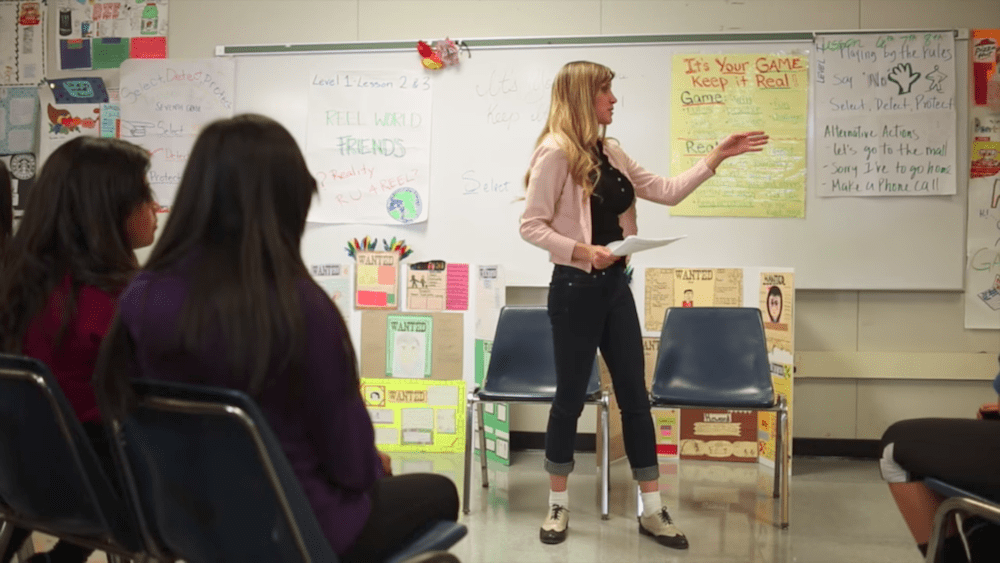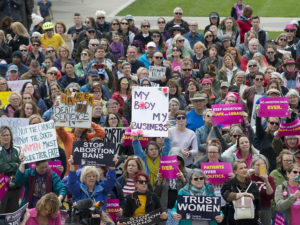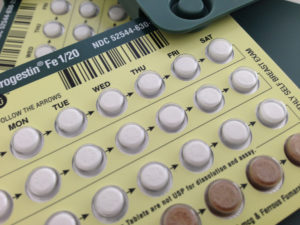Teens Say Pregnancy Prevention Programs Are Worth Keeping
Educators and health researchers worry that youth pregnancies could climb again with the Trump administration's stance on prevention and sex ed programs. The Los Angeles teen pregnancy prevention program for which Larissa Karan, above, teaches received $2 million in federal health funds this year but will lose its $4 million in funding for the next two years. (Keeping It Real Together)
The Los Angeles teen pregnancy prevention program for which Larissa Karan, above, teaches received $2 million in federal health funds this year but will lose its $4 million in funding for the next two years. (Keeping It Real Together)
LOS ANGELES – The seventh-graders filed into the room and took their seats. On the first day of Pio Pico Middle School’s teen pregnancy prevention program, the 12-year-olds weren’t learning about condoms and sexually transmitted diseases. They were learning about friendship.
There was a crackle of excitement as their teacher, vivacious in a bright cotton dress with flowers in her hair, handed out scripts for a dramatization of real-life relationships and sexual encounters, starting with the basics.
“How many of you have friends?” Hands went up. “How many of you like to have friends?” Hands again. “Today, we’re going to learn all about friends.”
Larissa Karan, a teacher with 16 years of experience who received extra training for this class, in August had the 28 students contemplating answers to personal questions they probably never had encountered before. Over the next two years, with a dozen sessions, these students will act out roles focused on how to say no to sex, how to talk to their parents about problems and how to keep healthy and safe.
But in July, the U.S. Department of Health and Human Services suddenly pulled the plug on this project and 80 others funded by the government’s Teen Pregnancy Prevention Program, as first reported by Reveal from The Center for Investigative Reporting. The department eliminated the last two years of five-year grants awarded by the Obama administration. With the loss of nearly $214 million promised nationwide, the future of these programs remains uncertain.
The programs, which reach 1.2 million adolescents in 39 states, rely on medically accurate information and use techniques teaching abstinence and contraception that have been scientifically validated as effective. But they are controversial with abstinence-only advocates in the Trump administration.
Educators and health researchers now worry that teen pregnancies, which have been cut in half in the United States over the past 10 years, could increase again.
These programs are particularly valuable in cities such as Los Angeles with large low-income and minority youth populations. With a large proportion of Latino students and 80 percent of the student body coming from households that qualify for free lunches, Pio Pico is an example of the populations most at risk: Nationwide, the pregnancy rate for Latino and black teens between 15 and 19 is roughly twice the rate for white teens.
Overall, nearly 230,000 babies were born to U.S. teens in 2015.
“These kids are hungry for trusted information,” said Kristin Meyer, director of youth prevention programs at the Los Angeles County Department of Public Health. “This initiative was intended to provide a larger pool of approaches that are effective in teaching abstinence and safe sex.”
A dramatic teaching method
At Pio Pico, Karan leads the seventh-graders down the hall to the activity room and asks for volunteers to play roles in a class drama, “Jazmine Has a Secret.”
The students read the script. A worried Jazmine reluctantly shares a secret with her friend Gaby. Jazmine’s 15-year-old sister found out she’s pregnant. Her boyfriend broke up with her and she’s afraid to tell their mother.
“She’s really scared and doesn’t know what to do,” Jazmine tells her friend.
Jazmine leaves. Two other friends approach Gaby. Alicia repeatedly presses Gaby to reveal Jazmine’s secret.
The other friend, Jose, says, “Hey, Gaby, if Jazmine told you not to say anything, then maybe you shouldn’t.” Then he says to Alicia: “Man, you need to chill. Why are you getting into her business? If Jazmine wants you to know, don’t you think she’d tell you?”
The play ends with Gaby looking worried, saying, “Well … ”
Now Karan jumps back in. She peppers the class with questions. “How many would want people telling a secret?” No hands. “How many would want Alicia as a best friend?” No hands. “If someone told a secret at Pico, it might end up at L.A. High tomorrow, right?” They nod their heads and laugh.
“What makes someone a good friend?” Karan asks. The descriptions stream in from the students: trustworthy, honest, encouraging, caring, loyal, nice. If you’re in a tough situation, they’ll be by your side. They don’t betray you.
“A bad friend?” They hate you. User, thief, bully, liar, evil, scary, twisted, gossipy, bossy. They talk behind your back.
Buried in this role-playing are messages telling the kids that they need to take care in forming intimate relationships. They are taught that they are free to say yes or no at any time, for any reason, to anything – and that includes sex.
The program, developed by the county public health department and University of Southern California’s Department of Preventive Medicine, received $2 million in federal health funds this year but will lose its $4 million in funding for the next two years. It serves 45 middle schools in the Compton and Los Angeles unified school districts plus 11 sites in high schools run by charter school Soledad Enrichment Action.
“This is practice for them to test out scenarios of real life and build confidence in saying no,” Karan said after class. “They are preparing against being caught off guard in risky situations, whether it’s drinking, making out on the couch, riding in a car with another teen or cutting school. It’s good to see them stand up for themselves. It’s hard to resist peer pressure.”
‘A double hit to the community’
To qualify for the federal funds awarded by the Obama administration starting in 2010, the 81 teen pregnancy prevention programs had to provide evidence that they actually worked. They teach comprehensive sex education – abstinence as well as contraception.
In June, Trump appointed Valerie Huber, the former president of a national abstinence-until-marriage organization, as the chief of staff to the assistant secretary for health. A few weeks after her appointment, that office informed the teen pregnancy grant holders that their funding would stop at the end of the 2017 fiscal year.
The elimination of the funds was done outside the traditional federal appropriations process. Yet it is still possible that Congress will step in to save the Teen Pregnancy Prevention Program: In July, 148 members of the House and 37 senators signed letters asking the health department to justify the cuts. The House appropriations bill would eliminate the program and substitute $20 million for abstinence-only programs. The Senate is leaning the other way so far: Its appropriations committee approved keeping the program for 2018.
Huber declined to be interviewed. But in August, she told a radio audience in Columbus, Ohio: “We’re hopeful Congress will eliminate the Teen Pregnancy Prevention Program. If they choose not to, we have every intention to improve this program so more young people are helped as a result. The program as designed and promoted simply isn’t working.”
As evidence, she pointed to evaluations that found 12 programs in the initial 2010-15 grant period reduced risky sexual behavior among teens, 16 did not and 13 were inconclusive.
However, social scientists with the Brookings Institution say those results show that the programs were making progress and that axing them is a “grievous and ill-considered decision.” Overall, major studies show that programs such as these contribute to drops in teen pregnancy when they incorporate contraceptive information; ones that rely entirely on persuading teens to abstain from sex are ineffective, waste money and are dangerous to their health.
Meyer, of the Los Angeles County Department of Public Health, called the loss of the grant funds “a double hit to the community. Not only are students going to be denied these programs, there also will be less evidence to help districts identify the best ones for their students.”
Reaching out in coal country
Deep in rural Appalachia, adolescent birth rates soar – they’re nearly four times the national average in some places.
Mission West Virginia, a nonprofit that serves youth and families, was using the federal funds to eventually reach 55,000 teenagers in sixth through 10th grades in 100 schools, group homes and juvenile centers with its THINK program, or Teaching Health Instead of Nagging Kids. The goal was to help every teen in counties where poverty and social problems fuel high teen birth rates, particularly in rural areas that were once the center of mining.
In the coal town of Morrisvale, Alyssa Stone, now 15, has taken sex education classes since she was 12. She says the program has made it easier for her to talk to her mom and to boys.
“It made it a lot easier to explain how to say no. If you have a real friend, you can tell them you’re not going to be pressured and you’re not going to be that kind of person,” she said. “We thought it was going to be just another boring class, but everybody learned a lot. We had no idea how easy it was to get STDs.”
She is concerned that if the nonprofit group can’t find other funders to replace the $1.7 million annual grant, the health classes will disappear.
“I’d really like for my little sister to go through the program. She needs it and doesn’t realize it,” she said about her 12-year-old sister. “Kids that age think they know a lot.”
Alyssa’s mother, Hilary Stone, who gave birth to her at a young age, said people act like if you don’t talk about teen pregnancy, it doesn’t exist.
“It’s already in their heads,” Hilary Stone said about teens and sex. “Why not give them the right information rather than let them figure it out on their own?”
Religion is important in this Bible belt community, she said, “but I think parents around here would appreciate someone coming to teach. If they could push it off on someone else, they’d be glad.”
Talazia Walther, 17, a high school senior, lives in the former coal town of Madison. At 14, she learned she was pregnant. Her son, Grayson, is now 2.
“I had to depend all on my mom,” Walther said. “It does take away the life of being able to hang out with my friends. You do have a big responsibility on your hands. But I wouldn’t change it for the world.”
Walther is a top student with straight A’s. She intends to go to college and study pediatric nursing. After school, she works at Wendy’s from 4 to 10 p.m., earning minimum wage.
The first sexual health class offered at her school came after she already had given birth. Nevertheless, she said, it helped her.
“The class taught me I was in an abusive relationship,” Walther said. “I ended up getting out of it, and I’m so much happier.”
Helping Miami’s immigrant teens
In Florida’s Miami-Dade County, the pregnancy prevention program focuses on neighborhoods with twice the national teen birth rate. Twenty ZIP codes there have a quarter of the county’s girls ages 15 to 19 – and more than half of the teen births.
Trinity Church developed its program, PlanBe, with input from Haitian, Cuban and Honduran immigrant teens. With its federal health grant of more than $1.4 million per year, the staff of mostly young health educators teaches 6,000 kids a year. But the program may have to be discontinued now that the funding has been withdrawn.
Marcus Carreño, a personal fitness teacher at Miami Senior High School in the predominantly immigrant neighborhood of Little Havana, said PlanBe classes encourage young people to come forward with hidden fears. He said one girl confided to a staff member that she had been raped and feared she had HIV.
“She might have lived her entire life without telling anyone,” Carreño said.
The PlanBe staff teaches not only about abstaining from sex, but also about life lessons, he said.
“They let the kids express what they feel and set up stories and plays, like trying to get a girl to smoke weed and go have sex,” he said. “Then they switch it and make the girl try to seduce the boy. The kids are interactive in the whole process.”
Youlynie Coriolan, 17, didn’t have sex education until she attended Miami Lakes Educational Center in Miami Lakes, one of Trinity Church’s target schools. She moved to Florida from Haiti when she was 9. During middle school, she heard the “secrets of the boys” from her father, who taught her how to say no and humorously described boys’ flirting and “what they want for this moment.”
Trinity Church’s program taught complete information on sex, Coriolan said, along with how to respond to situations such as other teens saying sex is better without condoms.
“The moment you leave your comfort zone and have sex, you could end up getting pregnant. That got me thinking a lot,” Coriolan said. “Friends will push you to do what they like to do.”
Fritz Casseus, 18, a senior at North Miami Senior High School, another target school, took the sex education class last year.
“Some kids think it’s cool to live in the moment and not think about the future. I think that’s really risky,” Casseus said. He praised the staff at the Trinity Church program for “knowing what it feels like to be a teenager” and making the classes enjoyable, not awkward.
Casseus came from Haiti when he was 2 to be adopted by family friends. His high school serves a community that is 99 percent Haitian American, with a large number of low-income families and little access to health care. Many of the teens don’t have doctors to ask questions.
Teacher Lauren Zelniker, who’s taught at North Miami for 20 years, has scheduled the class for 1,000 students each year. A registered nurse, she said the program is “medically accurate on abstinence and birth control. They do it so it’s age appropriate. They are spot on with statistics. They do an outstanding job. Because I teach it, I’m very critical.”
Modern media for modern kids
In western South Carolina, Spartanburg County teens have taken the pregnancy prevention message outside the classroom by using Facebook, Twitter, Thunderclap, Instagram and Snapchat to attract their peers to a website with information about health, including birth control services. Their recent Thunderclap campaign reached more than 50,000 people, according to its website.
Rebecca Turner, 17, a student at the Scholars Academy public high school in Duncan, is one of 10 youth ambassadors for the Connect program, which teaches abstinence to preteens and birth control methods to older students. The program has served more than 3,500 students and received about $1 million a year in federal funds.
“Teenagers can be empowered to take control of their health,” said Turner, who is a whiz on social media.
After the local Mary Black Foundation received its first federal funds to start Connect, the county’s teen birth rate fell dramatically. There were nearly 500 babies born to Spartanburg County teens in 2010, compared with fewer than 240 born in 2016.
Youth ambassadors for the Connect program show up at downtown concerts and food fairs in T-shirts that say, “I Got This,” and hand out information to teens about the program.
Turner and other teens are so upset over the federal cuts that they created a social media campaign to restore program funding, urging people to text “resist” to 50409 to connect them to their congressional representatives.
“We hope people will text that number and tell their representatives they care about teen health,” she said. “We do.”
Your support is crucial…With an uncertain future and a new administration casting doubt on press freedoms, the danger is clear: The truth is at risk.
Now is the time to give. Your tax-deductible support allows us to dig deeper, delivering fearless investigative reporting and analysis that exposes what’s really happening — without compromise.
Stand with our courageous journalists. Donate today to protect a free press, uphold democracy and unearth untold stories.






You need to be a supporter to comment.
There are currently no responses to this article.
Be the first to respond.